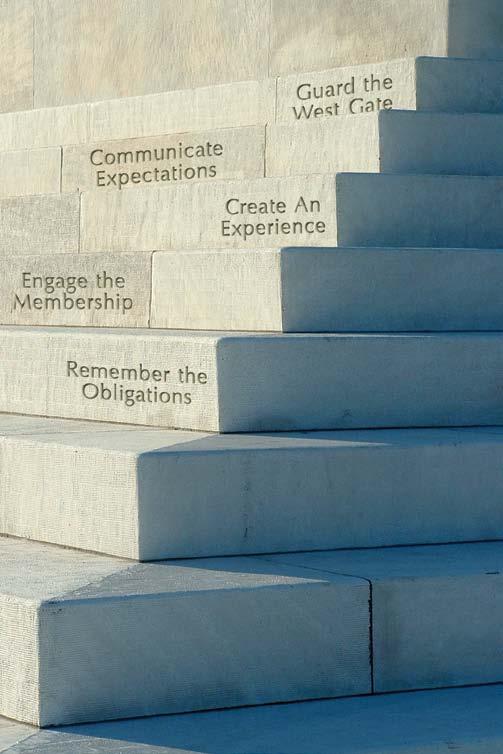
6 minute read
Take Five for Freemasonry
As Freemasons, we are taught to be builders and toil in the quarries of our Craft under the guidance of other Master Masons. For years, the Mason was tutored by a wise mentor, learning how to build the awe-inspiring structures that will last thousands of years. This gentle guidance on how to construct our great temples (lodges) is often lost or overlooked as we work within our lodges with our members. Too often, I have heard, “Why are they not coming back to lodge?” or, “What do we need to do in order to make our lodge stronger?” For those who have seen their lodges grow and prosper the last twenty years, the answer is clear… create a design upon the trestle board that can be followed by the newly made Masons and the Fellowcrafts who are yearning to learn the secrets and practices of this noble institution that will one day enable them to become true Master Masons.





On the path of becoming Master Masons, the ritual teaches us to draw designs upon the trestle board; yet too often, we find the trestle board bare, leaving our newly entered, passed and raised brethren wandering about, oblivious to what actions they should take and work they ought to perform in

Garrison K. Courtney, Grand Marshal
President, Masters and Wardens Association

order to develop and better themselves through our sacred art. Without these designs, our members become complacent and leave the quarries of the Craft to slip quietly back amongst the crowds, tossing their aprons onto the piles of others who have sought to learn this ancient and regarded trade. How then, do we create a design that will encourage and facilitate the learning experience for our craftsmen? Develop simple yet effective plans that focus on educating and enlightening our members as they go through the process of becoming Master Masons. The following are five steps that several lodges have taken to assist them in fulfilling this objective more successfully. These steps have proven to be effective not only in our lodges, but in the business world as well.




First, guard the west gate. One motivated craftsman is worth a hundred who sit around and do nothing. Remember the adage that “Freemasonry seeks to assist GOOD men in bettering themselves;” NOT, “Freemasonry seeks to assist mediocre men in becoming good.” Often, the lodges that are successful do not have hundreds of Masons. In fact, many of these successful lodges have between 20-30
hardworking, dedicated, and spirited members who invest their time and energies to make sure that new members are engaged, educated and mentored as they move through the process of becoming Master Masons. Second, communicate expectations to new as well as seasoned Masons. You will be surprised to find that many Masons do not know what their lodge’s expectations of them as members are or, in the case of officers, what their expected roles are within their lodges. If leaders of lodges don’t know their roles, how could we expect new Masons to be truly engaged in and properly educated about the Craft? Communicating expectations and commitment UPFRONT allows for better planning, attendance and engagement by new and older Masons. Communicating time commitment and attendance expectations to potential members enables the lodge to better assess whether a candidate is truly ready to be initiated into Freemasonry at this point in his life, or whether it might be better for him to wait a little bit before petitioning the lodge. This process increases the odds of having new members come to lodge and become involved in it instead of wandering away from the lodge and never returning to it.



Third, create an experience for new Masons. This does not mean having fireworks or circus clowns at every degree! We find that lodges that are successful often have their members share “an experience” as they went through the process of the three degrees. I have taken the time over the past few years to speak to many new Masons asking them about their “experience” in Masonry. Almost all of them have remarked, “Freemasonry is not what I thought it was.” Yet, when one talks to Masons who have been members of the Craft for twenty or more years, one finds them often recalling with great seriousness and fondness ritual and fraternal experiences that had made deep and lasting impressions on their minds. Take the time to visit their home during an investigation, talk to their families about Freemasonry, answer their questions and CALL or check in on them as they go through the process. In summary, when we invest in our members by having them share a unique experience through Freemasonry, they will in return invest in us and our fraternity.
Fourth, engage the membership. Too often we see members in lodges put into roles that they either dislike or are unable of performing. What does this do for the lodge and the membership? Nothing! Let us talk to our members, discuss their aspirations and expectations, and then find out how they can best become engaged and be of service to the lodge. Do they want to become officers or be on certain committees? Do they have experience dealing with finances? Are they good at public speaking, or do they prefer to write? By knowing the interests and skill sets of our members, we can help them take on roles and assume responsibilities that bring about positive growth and great satisfaction to them as well as the lodge’s membership.


Finally, adhere to and reflect upon the obligations we take as Freemasons and teach them to the new members so that they in turn can better understand them and truly live them. The many strong lodges that I have visited within and without our jurisdiction have made a conscious decision to encourage their members to seriously study and fully comprehend the significance of our Masonic obligations. How many holidays pass by that we don’t call or check on our widows and sick members? How many brothers lay ill without a note or call from a lodge member? How many brothers are experiencing the pain of a lost job or financial troubles without any recognition and without the guiding hand of a trusty brother? Our obligations and ritual are what makes us Freemasons! I like to tell new members as they embark on their Masonic journeys that becoming a Freemason may seem easy, but being a Freemason by living our Masonic obligations is very hard indeed!




The success of a lodge has many aspects and depends on different measures that ensure its good governance and effective management. The five steps outlined above are only a beginning towards achieving the goal of having more vibrant and healthier lodges. n








